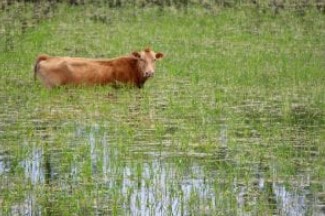By Garth Ruff
Low hay inventory this past winter combined with poor pasture stands due to excessive moisture have led to a greater proportion of thin beef cows both across the countryside and on the cull market. As we evaluate the toll that this past winter took on forage stands, especially alfalfa, hay is projected to be in short supply as we proceed into next winter as well.

For a beef cow to be efficient and profitable, we must meet her nutritional requirements for maintenance in addition to those for reproduction and lactation. As a reminder, the hierarchy of nutrient use is as follows: Maintenance, Development, Growth, Lactation, Reproduction, Fattening. This applies to all nutrient categories, not just to energy alone. As we conclude calving season, we are entering the most challenging time in production cycle when it comes to providing adequate nutrition. If the cow does not intake enough nutrients and is in suboptimal body condition at calving (BCS < 5), reproduction is the first to fail. With that in mind, one strategy available to minimize body condition and reproductive losses when forage is in short supply is to early wean calves.
Early weaning is certainly not a new concept and is one that is often employed when forage availability is scarce. By shortening lactation and weaning calves earlier, a cow’s nutrient need above that of maintenance is greatly reduced. Keep in mind that we still need to provide enough nutrition to sustain the mechanisms of reproduction, estrus, implantation, and gestation.
Many universities have researched the pros and cons of early weaning from a herd and systems-based management approach. Taking a deep dive into the archives of the Ohio Beef Letter, I found these “10 Reasons to Wean Calves at 205 Days” written by Dr. Tom Turner in 1999. While these reasons are a bit tongue in cheek, there are also some good take home messages regarding herd management.
Number 10: Calves that are weaned later in life are less likely to grade ‘choice’ thus, being more attractive to the ‘high yield’ type markets.
Number 9: Seven month weaning instead weaning at 3-4 months keeps the stocking rates of pastures down, thus eliminating the need for carrying more cows.
Number 8: Weaning at 7 months allows the calf to be hungry due to declining milk production by mamma, thus encouraging calves to consume more creep feed.
Number 7: Weaning later will reduce early calf growth, thus allowing for more ‘compensatory’ gain in the feedlot.
Number 6: Weaning later keeps cows thinner and able to slip through gates and fences easier.
Number 5: Later weaned calves will weigh less and as a result can be marketed later with everyone else’s calves.
Number 4: Later weaned calves will weigh less and thus, should command more cents per pound than their heavier contemporaries.
Number 3: Later weaned calves can be creep fed to boost weaning weights. Since the feed conversion of creep feed is not very good, later weaning utilizes more cheap Ohio corn.
Number 2: Later weaning allows open cows to be culled in the fall with everyone else’s open cows.
Number 1: Lactating cows require as much as 2/3 more feed than dry, gestating cows – weaning at 205 days will eliminate any abundance of hay.
To elaborate further, physiologically at around seven months of age (traditional weaning), we are weaning the calf at a point when its passive immunity acquired via colostrum is at its lowest and active immunity is beginning to ramp up. Therefore, from a health standpoint we are increasing the risk of stress induced illness when weaning calves at “traditional” age.
Furthermore, by feeding calves on a higher plane of nutrition earlier in life higher we can accelerate their growth curve. This early growth and energy intake contributes to heavier carcass weights and higher quality grade potential, increasing the value of the calf’s carcass.
Can you manage lighter weight calves? In order to be successful in an early weaning system, economics, facilities, and labor need to be considered. Early weaning may not be for everyone, but it can be a useful tool particularly when feed stocks and forage are limited.